
Cichlids are fish from the family Cichlidae in the order Cichliformes. Traditionally Cichlids were classed in a suborder, the Labroidei, along with the wrasses (Labridae), in the order Perciformes, but molecular studies have contradicted this grouping. On the basis of fossil evidence, it first appeared in Tanzania during the Eocene epoch, about 46–45 million years ago. The closest living relative of cichlids is probably the convict blenny, and both families are classified in the 5th edition of Fishes of the World as the two families in the Cichliformes, part of the subseries Ovalentaria. This family is large, diverse, and widely dispersed. At least 1,650 species have been scientifically described, making it one of the largest vertebrate families. New species are discovered annually, and many species remain undescribed. The actual number of species is therefore unknown, with estimates varying between 2,000 and 3,000.

Lake Tanganyika is an African Great Lake. It is the second-oldest freshwater lake in the world, the second-largest by volume, and the second-deepest, in all cases after Lake Baikal in Siberia. It is the world's longest freshwater lake. The lake is shared among four countries—Tanzania, the Democratic Republic of the Congo (DRC), Burundi, and Zambia, with Tanzania (46%) and DRC (40%) possessing the majority of the lake. It drains into the Congo River system and ultimately into the Atlantic Ocean.
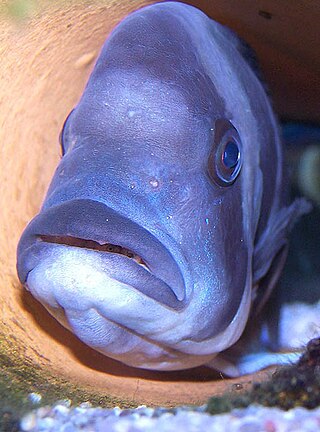
Mouthbrooding, also known as oral incubation and buccal incubation, is the care given by some groups of animals to their offspring by holding them in the mouth of the parent for extended periods of time. Although mouthbrooding is performed by a variety of different animals, such as the Darwin's frog, fish are by far the most diverse mouthbrooders. Mouthbrooding has evolved independently in several different families of fish.
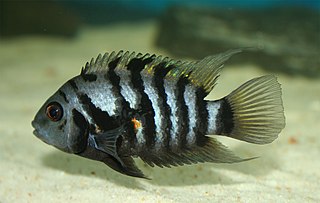
The convict cichlid is a fish species from the family Cichlidae, native to Central America, also known as the zebra cichlid. Convict cichlids are popular aquarium fish and have also been the subject of numerous studies on fish behaviour.

Julidochromis is a genus of cichlids in the subfamily Pseudocrenilabrinae. They are commonly called julies and are endemic to Lake Tanganyika in eastern Africa. This genus includes six formally described species, some with a number local variants of uncertain taxonomic status. Further taxonomic work is required to determine how many species exist; the closely related Chalinochromis with two more species is sometimes included here and this may be correct. Hybridization makes attempts to determine relationships with molecular phylogenetic methods difficult.

In biology, a pair bond is the strong affinity that develops in some species between a mating pair, often leading to the production and rearing of young and potentially a lifelong bond. Pair-bonding is a term coined in the 1940s that is frequently used in sociobiology and evolutionary biology circles. The term often implies either a lifelong socially monogamous relationship or a stage of mating interaction in socially monogamous species. It is sometimes used in reference to human relationships.

The Nile tilapia is a species of tilapia, a cichlid fish native to parts of Africa and the Levant, particularly Israel and Lebanon. Numerous introduced populations exist outside its natural range. It is also commercially known as mango fish, nilotica, or boulti.

Variabilichromis moorii has no common name and is a species of freshwater cichlid endemic to Lake Tanganyika in eastern Africa. It is a small ovate bodied fish named for an early collector of fish from the lake, John Edmund Sharrock Moore (1870-1947) who was a cytologist, zoologist and led an expedition to Lake Tanganyika and who discovered this species. Juveniles are usually yellow, and adults are dark brown to black in color. It reaches a total length (TL) of 10.3 centimetres (4.1 in). Currently it is the only member of its genus. V. moorii feeds on algae, zooplankton, and benthic invertebrates. It is also found in the aquarium trade.

Tropheus is a small genus of at least six species of cichlids endemic to Lake Tanganyika in East Africa. The genus is widespread across all regions of Lake Tanganyika, from Burundi in the north to Zambia in the south. Males and females are relatively similar in color, with only subtle sexual dimorphism in the form of the male's larger size. All species are maternal mouthbrooders, with the females caring for their eggs and fry in their mouths; this characteristic provides their generic name, Tropheus, which comes from the Greek trophos, which means "to nurse" or, according to Boulenger, "one who rears, brings up, educates". The genus is fished lightly by the local population, but has never become a staple food fish due to its relatively small size and its habitat, which enables it to dart between rocks when threatened.

Herotilapia multispinosa also known as the rainbow cichlid is a Central American freshwater fish of the cichlid family. It is found on the Atlantic slope of Honduras, Nicaragua, and Costa Rica from Patuca River (Honduras) south to Matina River, and on the Pacific slope of Nicaragua and Costa Rica from Guasaule River south to Tempisque River. Specimens are also reported from the Choluteca River on the Pacific side of Honduras. This species is found in lakes and swamps with muddy bottoms, where it uses its specialized teeth and only 3.5% jaw protrusion to feed mostly on algae. It is commercially important as an aquarium fish. The rainbow cichlid prefers a pH range of 7.0–8.0, water hardness of 9-20 dGH and a temperature range of 21–36 °C.

The Mozambique tilapia is an oreochromine cichlid fish native to southeastern Africa. Dull colored, the Mozambique tilapia often lives up to a decade in its native habitats. It is a popular fish for aquaculture. Due to human introductions, it is now found in many tropical and subtropical habitats around the globe, where it can become an invasive species because of its robust nature. These same features make it a good species for aquaculture because it readily adapts to new situations. It is known as black tilapia in Colombia and as blue kurper in South Africa.
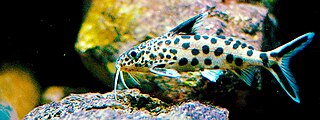
Synodontis multipunctatus, also known as the cuckoo catfish, cuckoo squeaker, or multipunk, is a small catfish from Lake Tanganyika, one of the lakes in the Great Rift Valley system in Africa. It is a brood parasite upon mouthbrooding cichlids. This species grows to a length of 27.5 centimetres (10.8 in) TL. This species is a minor component of local commercial fisheries.

Copadichromis borleyi is a species of haplochromine cichlid fish endemic to Lake Malawi in East Africa. The species is popular in the fishkeeping hobby where it is frequently kept in aquariums. The species has numerous common names, including redfin hap and goldfin hap.

Ctenochromis horei is a species of haplochromine cichlid which is found in East Africa.
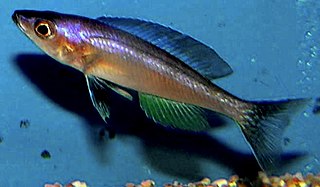
Cyprichromis leptosoma is a mouthbrooding species of fish in the family Cichlidae. It is endemic to Lake Tanganyika in Zambia and Tanzania. It seems quite common within its range and faces no particular threats, so the International Union for Conservation of Nature has assessed its conservation status as being of least concern.
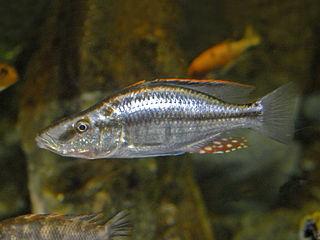
The Malawi eyebiter is a species of fish in the family Cichlidae. This predatory cichlid is endemic to Lake Malawi in East Africa.
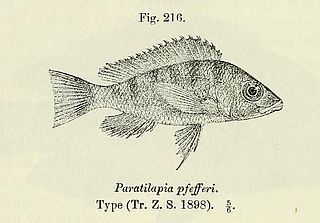
Gnathochromis pfefferi is an African species of fish in the family Cichlidae. It is endemic to Lake Tanganyika and its slow-flowing tributaries in the countries of Burundi, the Democratic Republic of the Congo, Tanzania and Zambia. It is common and widespread. This cichlid is found in relatively shallow waters, typically over soft bottoms in places with aquatic grasses.

Astatotilapia burtoni is a species of fish in the family Cichlidae.

Petrochromis polyodon is a species of cichlid endemic to Lake Tanganyika found in areas with rocky substrates where it can graze on algae. This species coexists with other herbivorous cichlids such as Tropheus moorii and Telmatochromis temporalis. Individuals can reach lengths of 40cm or 16 inches and 1kg in weight. They can be found in the aquarium trade.

Ritualized aggression or ritualized fighting is when animals use a range of behaviours as posture or warning but without engaging in serious aggression or fighting, which would be expensive in terms of energy and the risk of injury. Ritualized aggression involves a graded series of behaviours or displays that include threatening gestures and occasionally posturing physical actions such as inhibited (non-injurious) bites.






















